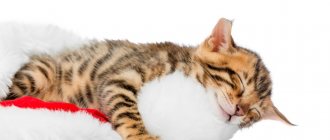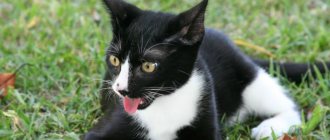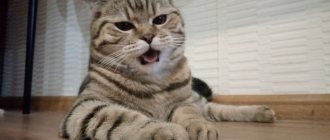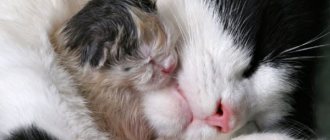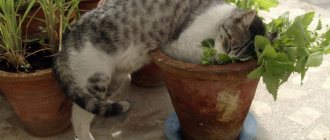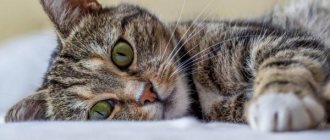The main marker of a cat's health is the animal's activity, and its breathing pattern is the second most important indicator of a cat's well-being. Violation of the usual rhythm of inhalation and exhalation for a particular pet becomes the basis for an emergency visit to the veterinarian.
Let's find out why cats' breathing becomes frequent or heavy, and what to do in such cases.
Rapid breathing as a variant of the physiological norm
A healthy cat inhales and exhales air silently. The system of supplying the animal's body with oxygen works imperceptibly; outwardly this is manifested only in uniform movements of the chest muscles.
Most adult healthy cats take approximately 30 breaths per minute, this amount corresponds to the norm - 20-40 times. The respiratory rate of kittens is slightly higher. It is about 50 breaths in 60 seconds.
What causes a healthy cat to breathe quickly?
Most often, this state of the pet is accompanied by an increased emotional background. There are many reasons that cause rapid breathing in a healthy cat.
Among them:
- unexpected fear;
- overexcitement;
- stress;
- dehydration;
- active games;
- meeting a dog;
- overheat;
- labor, prenatal period;
- excited state during mating.
Difficulty or rapid breathing in such situations is considered normal. After some time, the cat’s rhythm of inhalation and exhalation evens out, she calms down and begins to breathe as always.
Why does a kitten breathe quickly when sleeping?
Kittens, like all babies, are more mobile than adult animals. This is associated with their accelerated metabolism, increased reflexes, and rapid breathing rhythm. When a cat often breathes from his stomach after active games, this is considered normal, but if he is not eating well, you should take a closer look at the baby.
Inexperienced owners do not always understand what to do if the kitten is breathing very quickly. First of all, you need to evaluate the animal’s appearance, behavior, and breathing patterns. If the kitten meows hoarsely or wheezes, and mucus comes out of the animal’s nose, the baby needs treatment.
Some kitten owners worry when their pet breathes strangely in its sleep. In such a situation there is no need to worry. Cats see dreams and react to them in the same way as to real events. Very rarely do they sleep without dreams. Frequent breathing during sleep is a sign of emotional distress.
How to help your pet
Why is my dog shaking, lethargic and panting?
If the cat is in a state that is strange for the owner: he is breathing heavily from his stomach, walking rather lethargically, sticking out his tongue, then it is worth helping him. When it comes to a pregnant cat that has begun to breathe quite frequently, you should not take any action, since this is just a symptom of imminent labor.
Note! A frightened cat who has rapid breathing also does not need excessive care, since this condition is caused solely by stress. If the animal is languishing from the heat, you should help it; you need to take the pet to a cooler room and pour fresh water.
When it becomes clear that a cat has choked on something, it needs emergency help from its owner. You need to push the jaws apart with your index finger and thumb and use tweezers to remove the foreign object. You can help the cat in another way: you need to take the pet by the hind legs, while pressing on the stomach in the area of the diaphragm. The movements should push out an object that does not allow the animal to breathe normally.
If a kitten has breathing problems after vaccination, this indicates an allergic reaction to the components of the drug. It is necessary to provide the pet with immediate specialized assistance, which is determined by anti-shock therapy.
Cat in the heat
It is recommended to leave the animal in the clinic for a while so that if this reaction occurs within a few hours after the vaccination procedure, help can be provided without delay.
Pathological causes of tachypnea
Sometimes a cat breathes heavily because it is sick. The number of breaths per minute increases noticeably, the mouth is open, the sides rise and fall heavily. The cat seems to be short of air. In some cases this is what happens. For example, when a furry pet develops asthma.
Pathological causes of rapid breathing in a cat can be:
- blood diseases;
- ascites (excess fluid in the abdominal cavity);
- development of various myalgia (heart pathologies);
- airway spasm;
- lung diseases;
- increased pressure inside the abdominal cavity;
- foreign object inside the respiratory tract, trachea or bronchi;
- malignant neoplasms;
- painful growth of some organs.
Important! If a cat has difficulty breathing, only a specialist can determine the exact cause of the animal’s strange condition. Self-diagnosis is usually wrong. This results in the loss of valuable time for treating the pet.
If there is a suspicion that a cat has developed a respiratory pathology, experts advise paying attention to the appearance of the animal. If your cat's ears are flattened, he is overexcited, attacks or tries to hide, he may be under stress.
A frightened or irritated cat almost always breathes from its belly. But as soon as he calms down, breathing returns to normal. There is no need to treat such an animal.
Risk group
There are cat breeds that are prone to breathing problems. These animals were bred using multi-level selection, focusing on the most beautiful appearance. The result was a phenotype with characteristic features of the skull shape. This negatively affected the internal structure of some organs of the respiratory system. Such cats were called brachycephalic.
Persian, Himalayan, British, exotic and Scottish cats have wide muzzles, a characteristic nose shape, the larynx, trachea and jaw of animals are disproportionate to the length of the tongue. This combination is called brachycephalic syndrome (BAOS).
If your cat is brachycephalic, you need to handle him especially carefully, making sure that the animal does not overheat or become physically overtired. Such cats were unlucky from birth: their narrowed nasal openings are not able to ensure normal breathing. To inhale, animals exert certain efforts, which cause an even greater narrowing of the lumens of the nostrils. The airways are pulled inward.
Difficulty inhaling leads to stretching of the animal's laryngeal mucosa. The trachea of brachycephals is initially narrowed, and the palate is longer than that of an ordinary cat. All this negatively affects the functioning of the lungs and increases the load on the heart.
Moments of tension, sometimes even ordinary games, cause sniffling, bubbling in the chest, and coughing in brachycephalic pets. It is impossible to miss such symptoms. They signal the onset of the disease. This is the case when physical abnormalities sooner or later lead to illness.
Important! If a cat develops characteristic breathing difficulties, you should immediately take your pet to a veterinarian. Delay in the visit causes an increase in negative symptoms in the animal.
Respiratory system diseases
When a cat breathes from its belly, there are signs that its lungs are not receiving enough oxygen. The cause may be an infectious-inflammatory disease of the respiratory tract.
As a rule, furry pets get sick:
- rhinitis;
- tracheitis;
- bronchitis.
The cat's body actively fights infectious agents. Mucus is secreted, which contains many leukocytes. This is a normal reaction of the animal's immune system. However, mucus in the respiratory tract interferes with the normal process of obtaining oxygen, so the cat (or kitten) often breathes from its stomach.
A sick pet coughs and mucus comes out of its nose. As a rule, this is accompanied by high fever and an unpleasant odor from the patient’s mouth. The kitten is lethargic and suffers from diarrhea and vomiting. Ulcers form on the oral mucosa. A sick animal begins to wheeze and wheeze when breathing, cough, and sneeze.
Important! If the kitten is breathing heavily and its condition does not return to normal within a few hours, a visit to the veterinarian is required.
Non-infectious causes
It happens that a cat is breathing heavily due to an illness that is not associated with infection. For example, these could be problems with the soft palate or larynx (spasm, swelling).
Abdominal breathing syndrome is caused by the following pathologies:
- helminthiases;
- accumulation of fluid inside the chest cavity (hydrothorax);
- hiatal hernia;
- accumulation of air in the chest cavity (pneumothorax);
- inflammation of the sinuses.
Important! If, a few days after the operation, the cat continues to have difficulty breathing, the animal suffers from shortness of breath, it is necessary to urgently call a doctor. It would also be a good idea to check the condition of your pet’s gums, lips and nose. A bluish tint to the surfaces indicates the development of complications in the heart or respiratory system.
Diseases that are not associated with pathologies of the respiratory system
If a cat has damage to the spine, sternum or ribs, he will have difficulty standing up and try not to strain his chest by breathing. An injured animal breathes shallowly (through the stomach). He develops shortness of breath.
In this state, the cat does not allow you to touch the sore spots, meows loudly, and sometimes loses consciousness. He should be taken to the clinic urgently. Most injuries can only be treated with surgery.
Myalgia
Some cat breeds are predisposed from birth to developing cardiovascular pathologies. These are Maine Coons, British and Persian pets. But other members of the cat family often suffer from heart disease.
The first symptom of the development of myalgia in a cat is abdominal breathing. Then wheezing appears, the skin on the body turns pale, and the mucous membranes in the mouth become blue.
The cat is lethargic, does not eat anything, lies constantly, and breathes heavily. The animal quickly weakens, its heart beats strongly even in the absence of physical activity.
Important! If your cat is diagnosed with heart failure, you will need to give her an injection of a prescribed drug when an attack occurs. Then take it out into the fresh air.
The owner of a cat suffering from myalgia must be prepared to provide emergency assistance if breathing stops during an attack. Vigorously blowing air into the nose through cupped palms will help.
The effectiveness of assistance will increase if artificial respiration is alternated with chest compressions. But it’s best to have the doctor’s phone number handy.
Overheating
Sometimes the cat pant frequently due to the heat. If immediate action is not taken, the animal may suffer from heatstroke. Signs of overheating are:
- Temperature more than 40 degrees.
- Reddened mucous membranes.
- Rapid pulse.
- Predominantly recumbent position of the animal, the cat lies, breathes heavily, sticks out its tongue.
The amount of sweat that is secreted by the skin of a furry pet is unable to cool its body to normal temperature. To reduce body temperature, the cat opens its mouth and breathes heavily. For cats of exotic breeds, British, Scottish, Persian cats, an acceleration of the breathing rhythm in hot weather is considered normal.
Oncology
The clinical picture of this disease depends on the degree of development of the pathology, its type and location. Signs of the disease are:
- loss of appetite;
- decreased physical activity;
- increasing sleep time;
- weight loss.
A sick cat develops shortness of breath and its fur loses its shine. As the tumor grows, the animal wheezes and coughs more and more.
The cat is choking and wheezing: what to do
Seizures in a cat: causes, what to do, treatment
You need to open the mouth and pull the tongue forward, check the throat for foreign objects that should be removed, including mucus or vomit. This will help clear your airways. To do this, hold the cat by its hind legs and raise its head.
Important! If you suspect a spinal injury, you should not lift or move the animal.
If removal of the foreign body does not help, you must begin first aid.
First aid for respiratory arrest
Step-by-step instruction:
How to give artificial respiration to a cat
- Start artificial respiration: lay the cat on its side, pull the tongue forward, cover the mouth with your hand and straighten the neck. Air is inhaled through the cat's nose every 3 seconds. It is important that the chest rises, but does not arch from excess inhaled air.
- During artificial respiration, you need to check for a heartbeat. If the heart is beating but there is no breathing, you need to inhale air at a rate of 10 breaths per minute until the cat breathes on its own.
- If you are completely sure of cardiac arrest, begin chest massage.
- If respiratory arrest is detected and resuscitation begins, it is important that someone call a veterinarian or take the cat and its owner to the clinic.
Important! Cardiopulmonary resuscitation should not be performed if the cat is conscious.
Instructions on how to perform chest compressions on a cat
Associated symptoms
When a cat is brought to the doctor, first of all he asks about the signs that alerted the owner of the animal. Therefore, monitoring a presumably sick pet before visiting the clinic is very important. This helps to quickly make a diagnosis.
Signs that accompany the development of pathology of the respiratory system are:
- poor appetite;
- wheezing when breathing;
- increased heart rate;
- elevated temperature;
- rapid pulse;
- redness or bluish tint of the mucous membranes;
- vomit;
- swelling;
- diarrhea;
- the appearance of mucous discharge from the mouth or nasal openings.
The effectiveness of treatment for your pet depends on the amount of time that has passed since the onset of alarming symptoms. There are diseases that develop very quickly. For example, pulmonary edema. Delay in such cases can cost the pet’s life.
Dangerous symptoms if a cat breathes with its belly
Sometimes, during difficulty breathing, the pet may experience pain. Externally, this manifests itself as the following signs:
- the cat looks excited and scared ;
- the muzzle is stretched out in an unusual grimace;
- pupils dilated;
- tail pressed to body;
- mustache pressed;
- the animal is aggressive .
Heavy belly breathing is a sign that your cat is not feeling well. It looks as if the pet is trying to inhale air with its stomach and push it out when exhaling. This type of breathing is called abdominal.
Normally, the abdominal muscles should not be used. When healthy, there is a vacuum in the sternum around the lungs. It allows the lungs to expand when inhaling.
In addition to belly breathing, lethargy, aggression and the inability to stand up are dangerous symptoms.
What should an owner do if a cat is breathing frequently?
The owner of the animal should first determine the nature of the causes of tachypnea. To do this, you need to compare the condition, appearance and behavior of the pet. Based on observations, we can draw a conclusion about the physiological or pathological causes of the animal’s condition.
In the first case (active games, stress), you should simply give the cat time to restore its normal breathing rhythm. Conditions are created for the animal's peace and comfort. For example, if a cat overheats, be sure to give it something to drink and cool the areas of large vessels (armpits, belly, paw pads).
If you suspect a pathology, you should carefully examine the animal, check the integrity of the ribs and limbs. If an injury is detected, you need to quickly take the cat to the doctor.
A veterinarian’s consultation and treatment will be needed in any case if the animal’s condition does not improve within 3 hours, and the cat’s heavy breathing is accompanied by pathological symptoms. If tachypnea persists without physical exertion, overheating or stress, the animal must be examined by a specialist.
The cat is breathing heavily: how to provide first aid?
The animal should be observed. If abdominal breathing is associated with physiological reasons, it will pass within half an hour. You need to come to terms with abdominal breathing associated with pregnancy or lactation; this is a normal phenomenon. If your pet gets sick in a car, you need to stop and wait until the animal comes to its senses.
Special remedies have been developed against motion sickness. Veterinarians recommend giving 1 ml of Vetspokoin suspension or a drop of Stop-Stress per 1 kg of weight a couple of hours before the trip.
If heavy breathing is caused by hot weather, then the pet is moved to a cool place or the air conditioner is turned on, but so that the cold air does not fall on the cat. Otherwise, shortness of breath will occur due to bronchitis or rhinitis.
In all other cases, the animal must be shown to a veterinarian. Above we have given a fairly comprehensive list of problems, most of which only a doctor can identify and help the animal.
Be sure to read:
A cat sneezes: causes, symptoms, what to do, treatment methods, what should alert you
Diagnostic measures
A loving owner always knows the normal breathing rate of his cat. It is slightly different for each animal. Such indicators are determined individually, in the process of observing a calm cat.
Home diagnostics of a pet's breathing is carried out when the animal lies on its side, its stomach rises (inhale) and falls (exhale) steadily. It is necessary to count how many breaths are taken in 1 minute. The counting is repeated 2–3 times. Average values are considered normal for this cat.
The respiratory rate of the animal is compared with the obtained figures when there is a suspicion of disease. This diagnosis determines the severity of the cat’s condition and helps the veterinarian in identifying pathology.
Professional
After talking with the cat owner and examining the animal, the veterinarian sends the furry patient for tests. As a rule, the following are required: biochemical blood data, ultrasound (heart, chest), X-ray results of the neck, chest. If you suspect anemia or diabetes, you will need to test your pet's urine.
Advanced diagnostics include studies of the animal’s bronchi, CT, and rhinoscopy. Sometimes hormonal tests are also necessary.
When diagnosing pathology, the exclusion method is used. This means that from all possible diagnoses diseases that do not coincide with the test data of the furry patient are excluded.
What examinations will be required?
To understand what causes rapid breathing in a cat, the veterinarian will question the owner in detail about when and under what circumstances the symptom appeared, what the animal ate the day before, whether it could have been poisoned, etc. Next, he will conduct a visual examination with palpation and, most likely, will refer you for tests.
In most cases, you have to donate blood and undergo ultrasound diagnostics. Sometimes an x-ray is required. These methods will help you find out why your cat is breathing frequently and prescribe adequate treatment.
When you look at how much your pet’s stomach swells and how often he gasps for air, it becomes truly scary. After all, breathing problems are a direct threat to life. However, there is no need to panic, although you also cannot waste time - you cannot get it back. If the condition worsens sharply, it will be more difficult to help the cat.
You should show the animal to a doctor as soon as possible and find out why it is breathing incorrectly. In the vast majority of cases, the diseases are not fatal and respond well to treatment.
Treatment methods
Viral respiratory tract infections in cats are treated with antibiotics, immunomodulators, antiviral and anti-inflammatory drugs, and vitamins. Therapy is aimed at relieving the symptoms of the disease and preventing complications.
If a cat is diagnosed with trauma or cancer, surgical intervention is most often used. About half of the time a foreign body in the airway causes a foreign body to see a doctor, surgery is also required. Sometimes a cat's difficulty breathing, which is associated with a malignant tumor, is restored with the help of chemical or radiation therapy. In other cases, the doctor prescribes medication.
It happens that a cat breathes heavily with his mouth open and does not eat after undergoing surgery. This condition is part of the body's recovery process from the effects of medications.
Not all cats tolerate narcotic anesthesia easily. If it is determined that the cause of the cat's breathing jerks is pain or intoxication after anesthesia, the doctor gives the animal an anesthetic and prescribes a course of treatment. After some time, the animal’s breathing is restored.
Antishock therapy
When a cat's blood pressure drops rapidly, it goes into shock. The rhythm of its breathing is disrupted, and there is a high probability of the animal’s death. Anti-shock measures for such patients include adrenaline therapy, infusion therapy, diuretics, corticosteroids, and analgesics.
Sometimes the furry patient’s body reacts violently to some components of the vaccination preparations. After the injection (after about 20–30 minutes), the animal begins to breathe rapidly. To stabilize the patient's condition, the doctor uses anti-shock therapy.
Important! After any vaccination, 30–40 minutes are required. stay with your pet at the veterinary clinic.
Early detection of signs of changes in a cat’s breathing, timely examination and treatment help to avoid the development of pathology in the animal. It is important to eliminate the causes of tachypnea.
Experts recommend monitoring your pet’s physical activity, protecting it from stress, keeping it in a cool room, and monitoring its weight. Attention to your furry friend, careful attitude and competent care keep your pets healthy better than the most expensive medications.
Symptoms indicating a pet's health problems
In itself, intermittent abdominal breathing is a dangerous symptom indicating pulmonary dysfunction. If the cat has become lethargic, does not eat anything, prefers to lie down more and move less, it means that pathological processes are occurring in the body that require urgent medical intervention. Hot breath, dry nose, pale mucous membranes indicate an increase in temperature. If a cat has a fever, he will shake violently. The animal constantly lies on its side, sighs, and does not respond to the owner’s voice.
What kind of breathing is normal, and why can it be disrupted in healthy kittens?
Normally, adult cats take about 20-40 breaths per minute. In kittens this indicator is different. The number reaches 50-60. If the baby breathes more often, this may be due to the following situations :
- the kitten is scared, surprised, angry about something;
- he ran and jumped for a long time, was very active, which made his breathing difficult;
- the animal is very hot.
You can often notice how a kitten’s belly shakes, how often the baby swallows air when he is being transported. Other reasons - they were moved to a new place, torn away from their mother, taken out of their familiar environment. Naturally, the baby is worried and excited. That's why he breathes often. A little time will pass and everything will return to normal. However, you definitely need to watch your pet for some time.
When should you worry?
If you notice that the cat is inhaling air suspiciously often, while he may open his mouth slightly and stick out his tongue, then measures should be taken and a qualified specialist will help in this situation. Most likely, the furry will be diagnosed with pathological processes in the respiratory organs. It is possible that the diagnosis will reveal a disease that is not directly related to the respiratory system.
Professional help
If a cat with rapid breathing is examined by a veterinarian, then first of all, the owner of the mustachioed creature should be told about the possible causes of the problem and, together with the veterinarian, exclude physiological factors. After a thorough examination of the pet, the veterinarian will work according to the following scheme:
- determine the temperature of a sick mustache, which will help confirm or exclude the infectious nature of the disease;
- will give directions for biochemical and clinical blood tests - necessary to detect anemia, diabetes or infections;
- will detect the presence of worms in the tail (if any);
- to exclude tumors in the chest area, problems with the heart and peritoneum, the doctor will give a referral for an ultrasound and x-ray;
- in particularly severe situations, thoracentesis may be required, when the chest wall is pierced, which helps to identify the presence of excess air or fluid in the organs;
In case of injuries and oncological development of the disease, in most cases surgical intervention is necessary. In other situations, drug therapy is prescribed, which directly depends on the diagnosis made by a specialist.
In a state of shock (rapid drop in blood pressure), the pet needs to quickly restore its respiratory rhythm, which is done with the help of adrenaline therapy, infusion therapy, various diuretics, corticosteroids, and analgesics.
